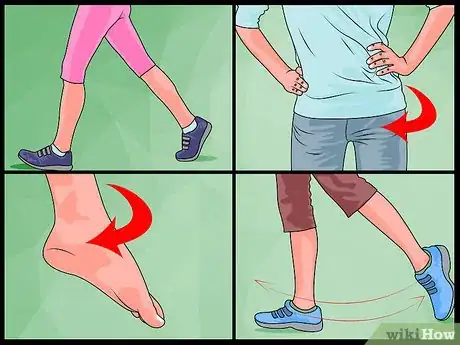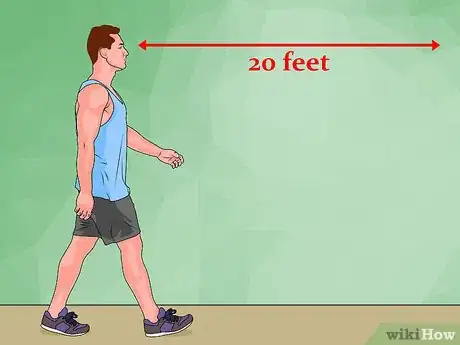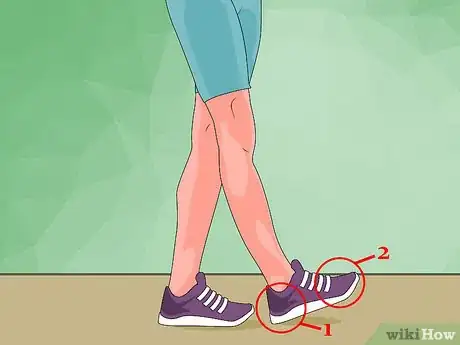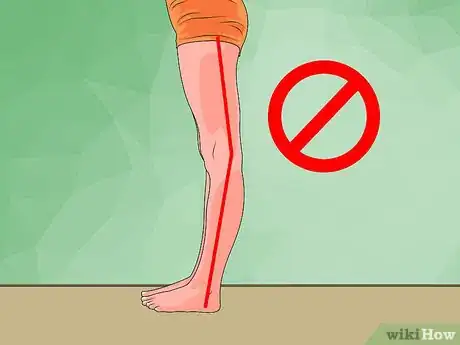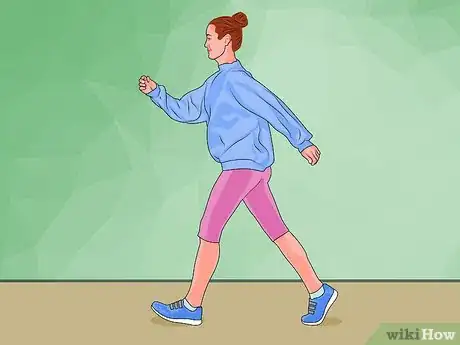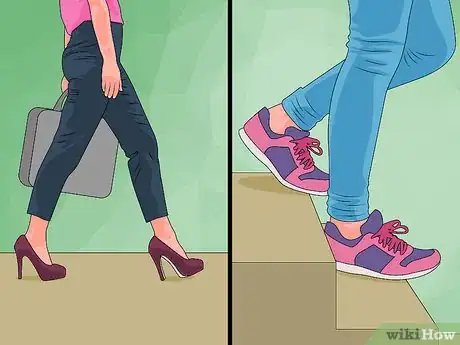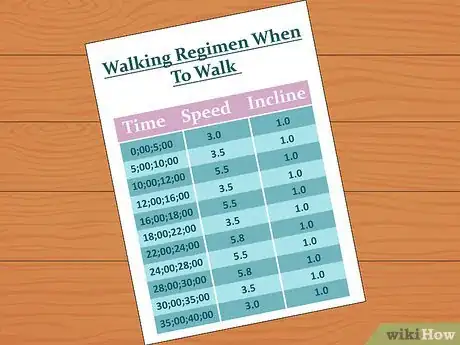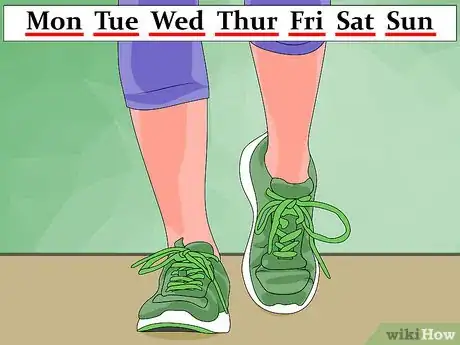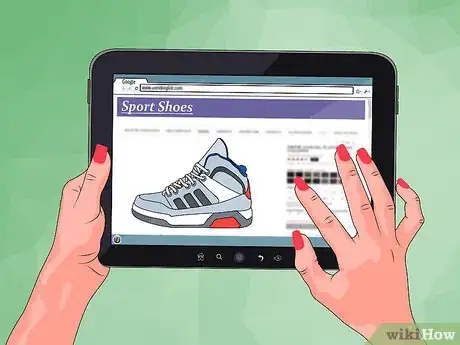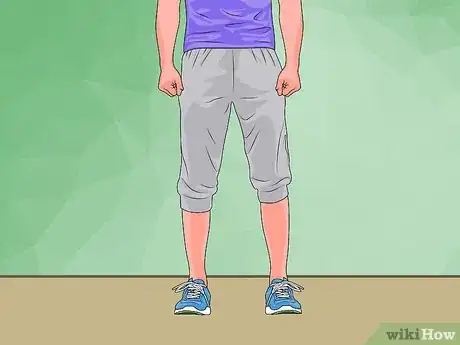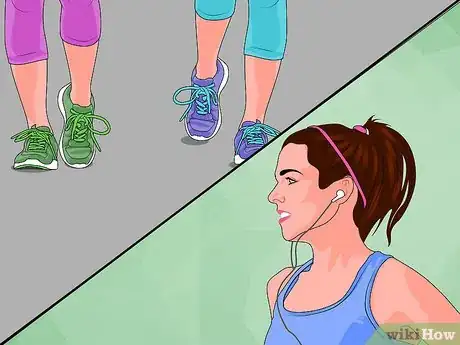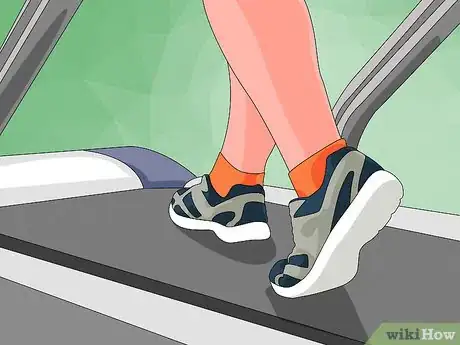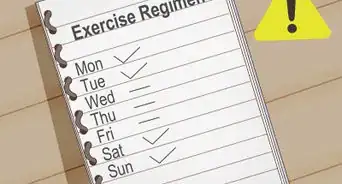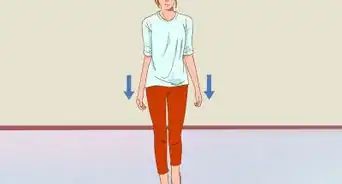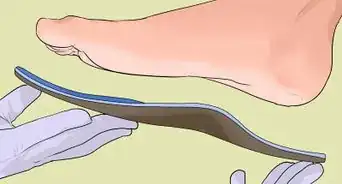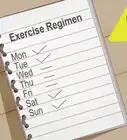This article was co-authored by Monica Morris. Monica Morris is an ACE (American Council on Exercise) Certified Personal Trainer based in the San Francisco Bay Area. With over 15 years of fitness training experience, Monica started her own physical training practice and gained her ACE Certification in 2017. Her workouts emphasize proper warm-ups, cool-downs, and stretching techniques.
There are 8 references cited in this article, which can be found at the bottom of the page.
This article has been viewed 651,099 times.
Walking is one of the best low-impact exercises, and it's also one of the cheapest and most convenient ways to get healthier; however, many Americans walk less than half of the daily recommended steps. Walking can reduce your risk of heart disease and cancer, while reducing chronic pain and stress.
Steps
Improving Your Walking Gait
-
1Warm up your body. Warming up your body by starting slowly when you walk will reduce over-exertion on your muscles. This can help you walk longer, and at a better pace. Try to warm up by walking slowly for five to 10 minutes at the beginning of the walk.
- This will loosen up your muscles and get them ready for exercise. To warm up, do the following for 30 seconds each: Make circles with each ankle; swing each leg; make slow circles with your hips or legs; make arm circles; march in place; and swing your legs back and forth.
- Similarly, cool down at the end of your walk by slowing down for 5 to 10 minutes. After you cool down, stretch your muscles gently.
- Warming up properly can help you avoid walking injuries, such as strained muscles.
-
2Improve your walking posture. When walking, try to use purposeful movements when you stride and pay attention to your posture. Make sure you have good, erect posture. Try to look 12-20 feet in front of you as you walk.
- Walk with your head up, while looking forward. Don’t look down at the ground constantly as you walk, which could strain your neck.[1]
- Relax your neck, shoulders and back. Although your posture should be strong, your body should not be held too stiffly as you walk.
- Swing your arms with a slight bend in the elbows if you want. Tighten your stomach muscles, and don’t arch your back forward or backward.
Advertisement -
3Walk heel to toe. When walking, you should step forward with your foot. Let your heel land on the ground in front of you. Then, roll your foot forward, transferring your weight to the ball of your foot. With your other foot, raise your heel, push your foot off the ground with your big toe, and repeat the first process.[2]
- Walking is different from running. Your feet should never lift off the ground completely at the same time.
- Find a stride that's comfortable for you. If you're losing track of the heel-to-toe motion, and aren't rolling your feet consistently, you may need to slow down.
EXPERT TIPMonica Morris is an ACE (American Council on Exercise) Certified Personal Trainer based in the San Francisco Bay Area. With over 15 years of fitness training experience, Monica started her own physical training practice and gained her ACE Certification in 2017. Her workouts emphasize proper warm-ups, cool-downs, and stretching techniques.ACE Certified Personal Trainer
 Monica Morris
Monica Morris
ACE Certified Personal TrainerOur Expert Agrees: When you're walking, your heel should land on the ground first, then your sole, then the toes. That allows your foot to work like a spring, so it assists your whole body in moving forward.
-
4Straighten out your legs if you have tight hips or hamstrings. If you sit too much, you may have a tendency to always bend your knees while walking. This usually means that your hip flexors and hamstrings are too tight. As you walk, make a conscious effort to straighten out your legs.
-
5Avoid hyperextending your knee. Hyperextending your knee means moving your knee backwards slightly when standing or walking. Some people may have a natural tendency to hyperextend their knees, but hyperextending your knee can cause increased stress to your joints. When walking, be conscious of your knees to avoid hyperextending them.
- Maintain a slight bend in your knee when walking, especially if you're prone to hyperextending your knee when standing. This will feel strange at first, but eventually your knees will adapt.
- Go slowly up stairs, moving in slow and deliberate motions.
- Avoid wearing heels too frequently, as this can encourage knee hyperextension.
-
6Walk at a fast pace. To get the greatest health benefits from walking, try to walk at a slightly faster pace than a mere stroll. Strive to walk with quick, not long, steps.
- Walking should be a moderate-intensity aerobic activity. This means that you’ve broken a sweat and your heart rate has risen.
- How can you tell if you’re walking fast enough? You should be able to talk but not sing a song while you’re walking.
- Three miles per hour is a good pace if you’re walking to improve your health. If you’re walking to lose weight, pick up the pace to 4 miles in an hour, which is a 15-minute mile.
-
7Make walking a habit. Try to build more walking into the course of your regular day whenever possible. If you get into a routine, you’ll soon see the steps and health benefits adding up.
- Walk to work or part of the way to work if this is possible. Take the stairs when you usually take the elevator. Get up and walk around after you sit for 30 minutes. You can reduce the chronic pain caused by poor ergonomics in the office by walking around for five minutes every 30 minutes. You may be surprised by how much your daily step total will go up by completing a five-minute walk every half hour.
- Park your car a ways from your destination so you are forced to walk. Build a regular stroll or walk with friends or family into your day after dinner.
- Some people walk around indoor malls or even up and down their company’s stairs over their lunch hours because they don’t have time or money to go to a gym.
Getting a Routine For Walking
-
1Start gradually. As with any exercise regimen, you might be more likely to quit walking if you try to do too much too soon. You also could strain your muscles. Be patient and work up to longer walks.
- Even though walking is a low-impact exercise, your muscles, joints and feet must adjust to new activity levels to avoid soreness and injury. Motivate yourself by remembering that you can burn about 400 calories from a brisk walk, although it takes about 5 miles to do so.
- If you want to lose weight, it’s a good idea to also reduce how many calories you eat per day and to eat healthier unprocessed foods. Try to add 2,000 steps into your daily routine when you first start walking. Sometimes you can add steps just by making small lifestyle choices every single day, such as taking the stairs at work when you could take the elevator.
- If you don’t see weight loss right away, it might be because you are starting to build up muscle, which is good. Be patient, and you will see results over the course of time. Slowly add more steps each week.
-
2Aim to walk for 21 minutes per day. If you prefer to have a few days off during any given week, that’s fine too. Just aim to walk a total of around 2.5 hours per week.
- One benefit of walking is that you don’t need a lot of specialized equipment to do it. You can walk wherever you are, even if you are on vacation. You don’t need to be in great shape to start doing it.
- You can go over the 2.5 hours per week recommendation as you slowly build your endurance for longer distances. The standard official health advice recommends 150 minutes of physical activity a week.[3]
- All of the fitness advice, although it might vary by a few minutes here or there, consistently recommends the same thing: Walking for several hours a week, however you divide those hours up, has enormous healthy benefits. Eventually, try to walk at least 30 to 45 minutes at a time.
-
3Walk almost every day. The number one key to many forms of exercise is consistency. If you walk irregularly or, say, once a month, you’re not going to see a lot of benefits. Make walking something you do regularly.
- If you build walking into your regular activities on a daily basis (or at least several times a week), you could see many health benefits. Walking reduces the risk factors that cause heart disease and strokes.[4]
- Indeed, walking can cut your risk of heart disease by 30 percent. It can also help control the risk of diabetes and cancer. Always check with your doctor before embarking on any new physical activity, especially if you have a medical condition.
- Lower blood pressure, lower cholesterol, and sharper mental acuity are all benefits from regular walking activity, which is a low-cost way to improve your health.[5]
Getting the Right Equipment to Walk
-
1Track your steps. Buy a pedometer to track how many steps you walk each day. Many smart phones are able to download free health apps that will also track how many steps you’ve taken every day.
- Shoot for 10,000 steps a day. Most people already walk between 3,000 to 4,000 steps a day just doing their normal activities, so it’s not that hard to achieve if you consciously try to do it. The Center for Disease Control suggests that at least 7,000 to 8,000 steps is a good threshold for a healthy adult.
- It’s possible to walk about 1,000 steps in 10 minutes. Ten thousand steps is about 5 miles a day.[6]
- Record your steps every day and figure out your daily and weekly average. The goal is for the average to go up gradually as your endurance increases and you walk more.
-
2Buy decent shoes for walking. Walking is a very inexpensive form of exercise, but you do need to invest in a decent pair of shoes. You can buy shoes specifically designed for walking both online and in-store. Running and cross training shoes can also work.
- Comfortable shoes that provide adequate support while walking are very important. Don’t wear shoes that cause blisters.[7] The shoes should have good arch support and thick flexible soles to absorb shock.
- Shoes suitable for walking should bend through the ball of the feet pretty easily while still being fairly durable. Choose a shoe with a low heel.
- High tops are not a great choice for walking unless they are specifically designed for walking or hiking, which a few of them are.[8]
-
3Wear the right clothing. Loose-fitting clothing with thin layers will not weigh you down, will reduce the chances of chafing, and will allow you to move comfortably.
- Some people choose a loose-fitting T-shirt or tank top and running shorts. Bright colors or reflective tape improve visibility.
- Beware of the sun, depending on season and climate. Wearing sunscreen every day is important to protect your skin from the ravages of the sun. You might also want to wear a sunhat or baseball hat.
- Wear a jacket if it’s cold or might rain. Make sure that you look at the weather forecast before walking so you’re dressed appropriately for the temperature.
-
4Stay safe. Walking outside comes with some hazards, so it’s important that you do it safely. Dangers include being hit by a car or tripping on an obstruction.
- Watch for traffic and stay observant as you walk, not lost in thought. Walk on sidewalks or on the left side of the street facing traffic if a sidewalk is not available.
- Carry your ID, a cell phone, and some change so that you can use a pay phone if you need to do so. Wear reflective gear if you are walking at dusk or night (which can be very dangerous).
- Take care when you wear headphones because they will screen out noise that can alert you of dangers. Consider wearing only one head piece in so you can still hear traffic.
-
5Switch the locale. Although walking can be a very relaxing and enjoyable activity, it can also bore you if you do it alone and along the same exact route every day.
- Instead, try walking in different locations. Walk around a park, down a riverside path, through woodlands, and down a subdivision road.
- Walk along a well-maintained route. Avoid courses that have cracked sidewalks, potholes, or low-hanging tree limbs that could cause injury. Listen to music on an MP3 player as you walk to reduce boredom. In addition, research has shown that brisk walks to active music increase blood flow to the brain and stimulate the release of a brain-derived neurotrophic factor (BDNF), a hormone that contributes to the production of new brain cells, which is particularly important as you get older.[9]
- Walk with other people, such as a family member, neighbor or other friend, so as to improve motivation. It’s also less boring to walk with someone else because you can talk on the way.
-
6Walk on a treadmill. If you live in a cold climate or you don’t have a good environment to walk in outside your front door, use a treadmill.
- The good thing about a treadmill is that you can set your speed and incline, as if you were walking outside.
- If you can’t afford to buy a treadmill for your home, many workout centers offer treadmills.
- Everything that applies to walking outside generally applies to walking on a treadmill, except that you don’t have to worry about traffic or tripping on obstructions in the sidewalk or roads.
Help Staying Entertained, Using the Correct Posture, and Creating a Walking Schedule
Community Q&A
-
QuestionI feel like walking is just a normal part of life. What's the difference between this and normal everyday walking?
 Community AnswerThis is a tutorial for people who have been unable to walk for long periods of time due to health problems.
Community AnswerThis is a tutorial for people who have been unable to walk for long periods of time due to health problems. -
QuestionWhen I walk in the street cars honk at me, is this normal?
 Community AnswerNo. You should not walk in the street, it isn't safe. Use the sidewalk if there is one, and only cross using a crosswalk when there is no oncoming traffic.
Community AnswerNo. You should not walk in the street, it isn't safe. Use the sidewalk if there is one, and only cross using a crosswalk when there is no oncoming traffic. -
QuestionDo I have to wear loose fitting clothes when I walk?
 Magic67Community AnswerIt is best to walk in clothes that you're comfortable in. Many people find loose clothes more comfy, but if you prefer tighter items, leggings or tight shorts and a breathable t-shirt would be best.
Magic67Community AnswerIt is best to walk in clothes that you're comfortable in. Many people find loose clothes more comfy, but if you prefer tighter items, leggings or tight shorts and a breathable t-shirt would be best.
References
- ↑ http://www.mayoclinic.org/healthy-lifestyle/fitness/in-depth/walking/art-20046261
- ↑ http://www.sparkpeople.com/resource/fitness_articles.asp?id=1220
- ↑ http://www.nhs.uk/livewell/loseweight/pages/10000stepschallenge.aspx
- ↑ http://www.heart.org/HEARTORG/HealthyLiving/PhysicalActivity/Walking/Walk-Dont-Run-Your-Way-to-a-Healthy-Heart_UCM_452926_Article.jsp#.V1baHr7uOJc
- ↑ http://www.health.harvard.edu/staying-healthy/walking-for-health
- ↑ http://www.nhs.uk/livewell/loseweight/pages/10000stepschallenge.aspx
- ↑ http://www.nhs.uk/Livewell/getting-started-guides/Pages/getting-started-walking.aspx
- ↑ http://www.emedicinehealth.com/walking_for_fitness/article_em.htm
- ↑ https://www.bbc.com/news/health-51024034
About This Article
To walk correctly, make sure you’re standing up straight and looking about 10 to 20 feet (or 3 to 6 meters) in front of you, since looking down while you walk is bad for your neck. You should also try to keep your knees slightly bent while you’re walking to decrease the impact on your joints, but don't do anything that feels unnatural. If you’re trying to walk more for exercise, focus on taking quick steps or walking uphill, which will help you break a sweat and get your heart rate up. You might aim to walk at a pace where you're still able to talk but too out of breath to sing. If you're just getting started, go for a 15-30 minute walk around your neighborhood 3 times a week to start building up your endurance. Keep reading for tips from our reviewer on how a fitness tracker or pedometer can help motivate you to walk!
